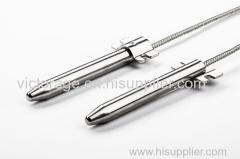
Pellet Grill Inside Temperature Sensor TPS200813-31
| Min. Order: | 5000 Piece/Pieces |
|---|---|
| Payment Terms: | Paypal, T/T |
| Supply Ability: | 20,000pcs one day |
| Place of Origin: | Guangdong |
Company Profile
| Location: | Shenzhen, Guangdong, China (Mainland) |
|---|---|
| Business Type: | Manufacturer |
Product Detail
| Production Capacity: | 20,000pcs one day |
|---|---|
| Packing: | Gift box |
| Delivery Date: | 25-30days for bulk order |
Product Description
As the key innovation enterprise in Shenzhen, TOPOS is one of the few sensors suppliers of the core technology and probe assembler. The key indicators of our types of thermistors and temperature sensors are far ahead in China, can compete with similar foreign products in the global market. Our company has 16 invention patents and 2 undisclosed technologies.
TPS24 type Microwave temperature sensor is a high level temperature sensor, very stable performance with very short response time, when you need to upgrade your product performance, this type temperature sensor can meet your demand.
Details
Material: semiconductor ceramic resistor chip/SUS304 stainless steel shell/high temperature shielded wire
Applicable temperature range: -45~500℃
Output signal: analog signal output
Advantages
600℉ temperature resistant PT1000 imported resistance chip
Material, length, size, chip,
The temperature resistance can be customized. No inventory, sampling is available.
Special temperature sensor for a wood pellet smoker, high-temperature resistance.
Fast response, high precision and good stability.
Application
Our pellet grill temperature sensor can be used as a special temperature sensor for a wood pellet smoker.
General Parameters
Nominal Resistance R0 | Tolerance | Toerance | Temperature range |
100ohm at 0℃ | Class 1/3 B | F 0.1 | 0℃to150℃ |
Class A | F 0.15 | -50℃to300℃ | |
Class B | F 0.3 | -70℃to500℃ | |
1000ohm at 0℃ | Class B | F 0.3 | -70℃to500℃ |
TC 0/100=3850 | -70°C to +500°C (continuous operation) (temporary use to 550 °C possible) | ||
Note: What is the B value:
A material constant that describes the resistance-temperature relationship. The value of B can reflect the scale of resistance to temperature change between two specific temperatures. As the temperature changes, the resistance value of a product with a large B value under the same conditions changes more, that is to say, it is more sensitive.

